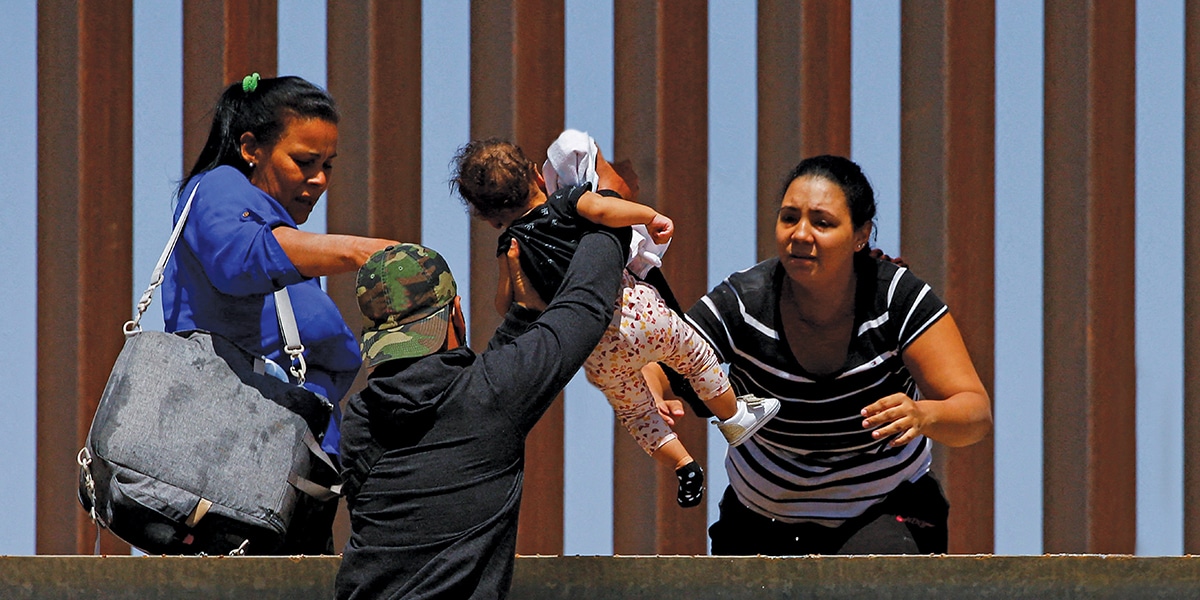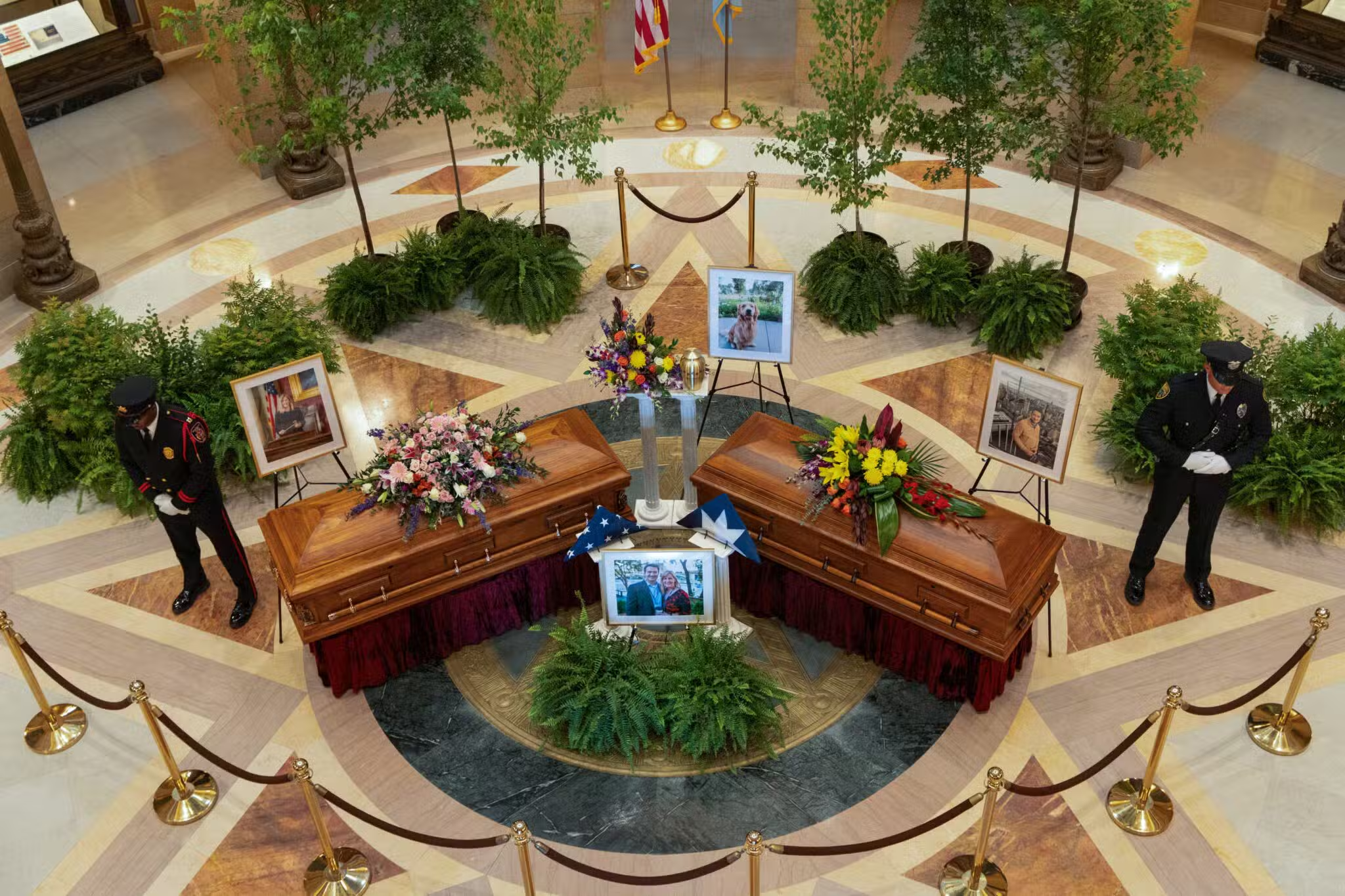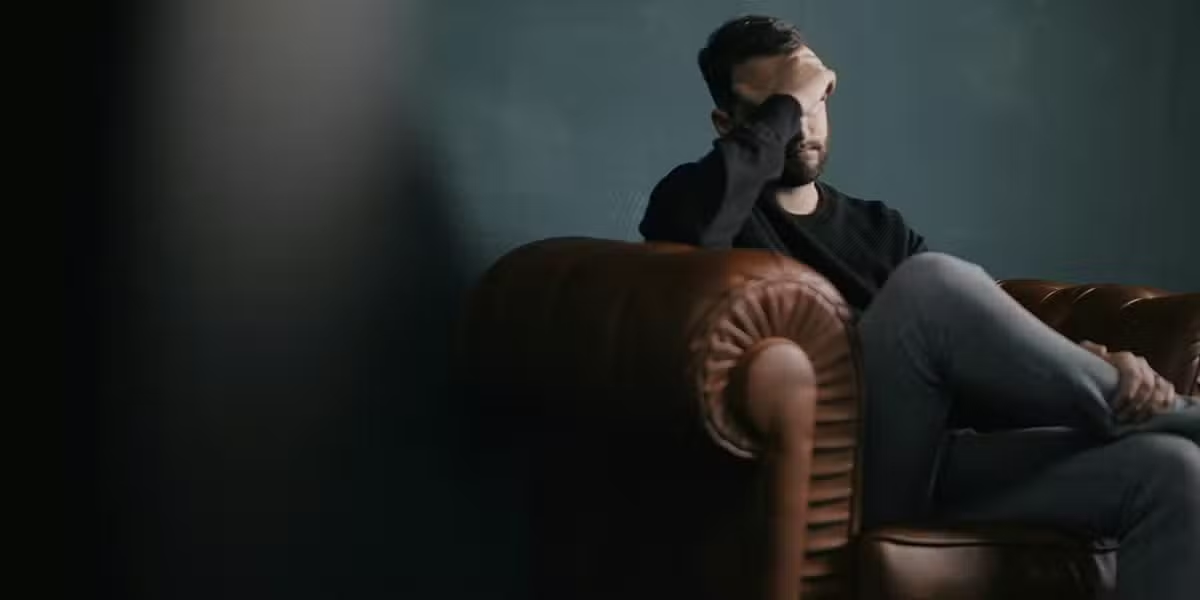When their parents brought them to the United States as children, they were too young to have a say in the matter. Now, as adults, they are advocating for the right to remain in the only country they’ve ever known.
Maria Vizcaino speaks like any other 26-year-old college graduate from the Atlanta suburbs. She carries a slight Southern accent, and her relatively fair complexion causes people to be surprised when they discover she is among the estimated 640,000 people who rely on DACA for her life in the United States.
“They expect a stereotypical Mexican,” Maria says.
Deferred Action for Childhood Arrivals (DACA) remains a mouthful of bureaucratese sometimes hard to follow for the uninitiated. Immigration advocates often use the term “Dreamers” to describe those, like Vizcaino, who came to the United States with their families as children illegally and now seek better lives. Vizcaino came here from Mexico when she was only 4 years old.
To obtain DACA status, immigrants must pay a fee of nearly $500, pass through an application process, meet all eligibility requirements, and have no felonies or serious misdemeanors on their records. They are then eligible for work permits. But DACA does not offer a path to citizenship. Only legislation passed by Congress could do that, and that doesn’t look likely in the current divisive political climate surrounding immigration issues.
Still, DACA offers hope for Dreamers. For Vizcaino, it provides an entry into American life, a pathway to success. “It’s been the biggest relief for me,” she says. Without it, she would be trapped in a nowhere land of no citizenship and no opportunities beyond a lifetime in the immigrant shadows.
Dreaming of Closure
The Dreamers emerged after President Barack Obama implemented DACA by executive action in 2012. That decision came after years of lobbying by immigrant activists. Obama argued that DACA assured participation in American life among those who arrived here as children, like Vizcaino, far too young to be held responsible for violating the law.
Vizcaino is a Dreamer who has taken advantage of the opportunities provided with DACA. A member of St. Philip Benizi Church in Jonesboro, Georgia, she graduated from Kennesaw State University with a degree in political science. She works as a legal assistant and plans to attend graduate school, advancing her own role as a young political activist.
Still, nothing is guaranteed with DACA. Vizcaino, like the other Dreamers, is obliged to avoid run-ins with the police and pay fees every other year to receive a stamp of approval to continue working. The program, while relatively uncontroversial—even President Donald Trump, not known as a champion of immigrants, spoke favorably about the Dreamers—is intractably swept up in the wider political arguments around immigration.
Congress has never approved it, and it hangs by a thread over the lives of its recipients. The directive has been regularly challenged in court, bouncing between rulings that have upheld it and others that threaten its very existence.
“It’s the fear of all of us that the courts could take it all away,” says Vizcaino, who has followed the ups and downs of DACA since emerging as an immigration rights activist during high school. Her fears were partially realized in July 2021, when the US District Court for the Southern District of Texas ruled that DACA was unlawful. However, as the case continues to be argued in the courts, current DACA recipients are allowed to continue in the program.
Speaking Out
José Cabrera, former director of education and advocacy for the Ignatian Solidarity Network, a Cleveland-based Jesuit social justice group, speaks frequently about immigration issues and his own former DACA status. Born in Mexico, he came to the United States at age 4 and settled with his family in Cincinnati. His father worked in construction; his mother cleaned houses and, in an inspiration for her son, worked as an immigration rights activist.
A leader in YES—Youth Educating Society—Cabrera has advocated for immigrant rights since his high school days and college years at Xavier University in Cincinnati. He speaks as an impassioned advocate for others, describing how DACA played an essential part in his story.
When Cabrera first came to the United States, his family stayed at an uncle’s home in North Carolina. He learned early about his limited rights in the country because he and his family entered illegally. “You have to understand. You have no rights here. You can’t talk to the police, or else you could be separated from your mother,” his uncle told him.
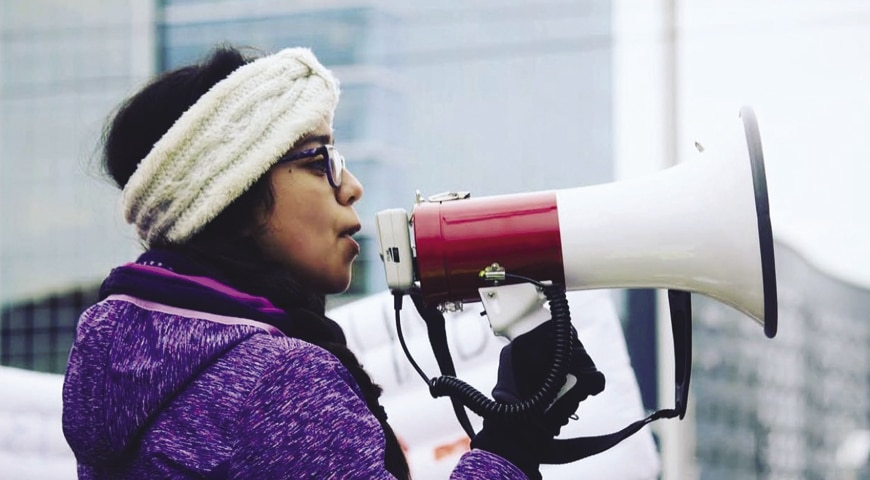
Sandra Oñate, a Dreamer born in Mexico, helps lead a rally in support of immigration reform in downtown Cincinnati, Ohio, in 2017.
DACA allowed him to continue his education. Eventually, Cabrera was able to emerge from the shadows and is now a legal US resident.
He says he felt the support of the community nurtured via his Jesuit education and the immigrant community that grew around the former St. Charles Borromeo Church in Cincinnati. Cabrera says the Church has been a vital source of support and advocacy for Dreamers. Still, while the institutional Church is on board, not all in-the-pew Catholics are as supportive, shown by the approval among some Catholic communities for the anti-immigrant rhetoric of former President Trump.
But for Cabrera, advocating for DACA is a faith imperative. “You should welcome your neighbor; you should welcome your fellow Catholics,” he says. “Welcoming the immigrant is very much a part of the Catholic Church.”
Sandra Oñate, 24, is another DACA Dreamer born in Mexico. She came to the United States with her family at 5, settled in Sharonville, Ohio, a Cincinnati suburb, and graduated with a degree in biology from Northern Kentucky University.
She became aware of her undocumented status while still in grade school. When her parents left for work, and she stayed at home with her sister, they were told to turn the lights out and to be careful talking to the police.
They found community at the former St. Charles Borromeo Church in Cincinnati with its large Latino presence. Oñate became an activist for DACA young people such as herself while still in high school. “I learned that my story was different. I learned how to tell my story,” she says. Part of that story is that she came to the United States with a degenerative eye condition, which, with the help of surgeries, she is now overcoming.
Every two years, she reapplies for DACA status, filling out the government paperwork, hoping that someday the program will become law.
The Catholic Response
While the country remains divided over DACA, the Catholic Church has adamantly supported its provisions and worked to make the program permanent via congressional action.
Even in a time when the Church itself can seem as divided as the nation at large, no Catholic authority has protested DACA provisions. Support transcends ideological differences among bishops. Pope Francis, who rarely comments on US politics, has shown that the Church stands with immigrants.
The bishops are following his lead. The United States Conference of Catholic Bishops (USCCB) argues that DACA should be enshrined into law by congressional action. Meanwhile, Church activists fight legal challenges to a program supported by the relatively flimsy thread of executive directive. President Joe Biden followed Obama in support of DACA and has been joined by Democrats in Congress. But action has stalled in the Senate.
Bishop Mario E. Dorsonville-Rodriguez, auxiliary bishop of Washington and chair of the USCCB’s Committee on Migration, noted the bishops’ support for DACA in a statement after a federal court ruling in Texas in June 2021. “We know that DACA was never meant to be a permanent solution for Dreamers,” he said. “This ruling is simply the most recent development in a long list of events warranting action by Congress. The Senate currently has multiple bills before it that would grant permanent relief to Dreamers, including the American Dream and Promise Act passed by the House of Representatives in March [2021].”
The bishop noted the contribution of Dreamers to the US economy, their service in the military, and how many were frontline workers during the COVID-19 pandemic. “But they are prevented from becoming full members of our society,” he said. “All Dreamers, not just those receiving DACA, deserve the opportunity to achieve their God-given potential in the only country most of them have ever known. This is not only a matter of human dignity but also family unity, considering the 250,000 US citizen children with Dreamers as parents.”
The bishop quoted Pope Francis: “Immigrants, if they are helped to integrate, are a blessing, a source of enrichment, and new gift that encourages a society to grow.”
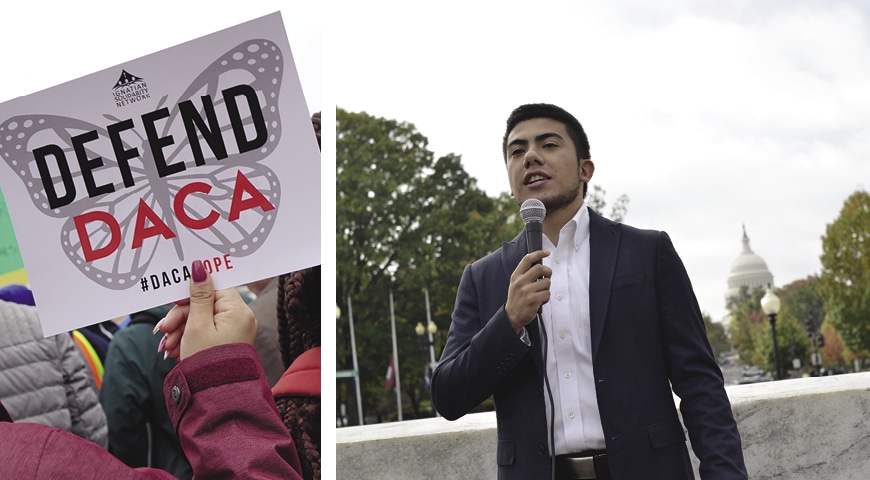
In 2017, José Cabrera, then a student at Xavier University in Cincinnati, shares his immigration story at the Ignatian Family Teach-In for Justice in Washington, DC. The annual gathering commemorates the 1989 martyrdom of six Jesuits and their companions in El Salvador.
Bishop Mark Seitz of the border Diocese of El Paso, Texas, is among those who have been most assertive in support of an immigrant Church that has long been established near the US-Mexico border. He expressed anger after the Trump administration threatened to end DACA: “Christians are fundamentally loving, forgiving people, just as Jesus lived and is, but there are some things that angered Jesus, and they should anger us as well. Some things should anger us enough to have the courage to speak out to people against their politically motivated assaults on the innocents.”
Archbishop Salvatore Cordileone of San Francisco noted: “When immigrants are no longer seen as merely a danger to others or threats to the local community but instead as persons, our feelings of animosity can morph into feelings of love and concern. As Catholics, we are called not only to know the stranger through the stranger’s stories but to welcome the stranger as Christ himself, for Christ reveals himself to us through them: I was . . . a stranger and you welcomed me’ (Mt 25:35).”
Echoing Pope Francis, the San Francisco archbishop argued that “an essential component of our role in welcoming the stranger is to place special attention on integration—uplifting the newcomer to help him or her reach full and dignified participation in our Church and society.”
The stance of the bishops is not surprising. They are acting in the long tradition of a Church built on immigrants in this country throughout the 19th and 20th centuries.
Back in 1988, the bishops established the Catholic Legal Immigration Network, Inc. (CLINIC), an advocacy and legal support service program for immigrants. It was a time of relative harmony and bipartisanship around immigration concerns. In 1986, a Republican president, Ronald Reagan, with the support of Democrats in Congress, offered a pathway to citizenship for undocumented immigrants. CLINIC, based in Washington, DC, was established to assist immigrants to process the necessary paperwork to prove that they had been long-established residents.
That almost-forgotten amnesty is now ancient history. The comity of bipartisanship around immigration issues is now a relic. Many Republican politicians express regret for Reagan’s amnesty, arguing that it failed to be accompanied by stricter border controls.
Even amid the partisan wrangling, there is hope that a DACA consensus could emerge. DACA recipients now are a central part of American life. While the public imagination focuses on the young, many are approaching middle age and have established careers, businesses, and families.
They are also essential to the country, argues Anna Marie Gallagher, executive director of CLINIC. Dreamers are all over the United States and are an integral part of communities beyond the immigrant hotbeds of large cities on the coasts or in the US-Mexico border region. “They are all American, for all intents and purposes, except for their place of birth,” she says.
Conflicting Viewpoints
Much of the ongoing debate over immigration involves seemingly intractable conflicts. Issues include: Should those who came here illegally be allowed the rights of US citizens? Will a pathway to citizenship applied to all undocumented immigrants only encourage more to crowd the borders? Is granting rights to Dreamers a reward for illegal behavior?
But DACA is different, says Gallagher. No one should argue that children should be punished for the decisions of their parents now that they are adults. Political factions in Congress, she says, should look to enshrine DACA into legislation because “this is something they can and should come together on.”
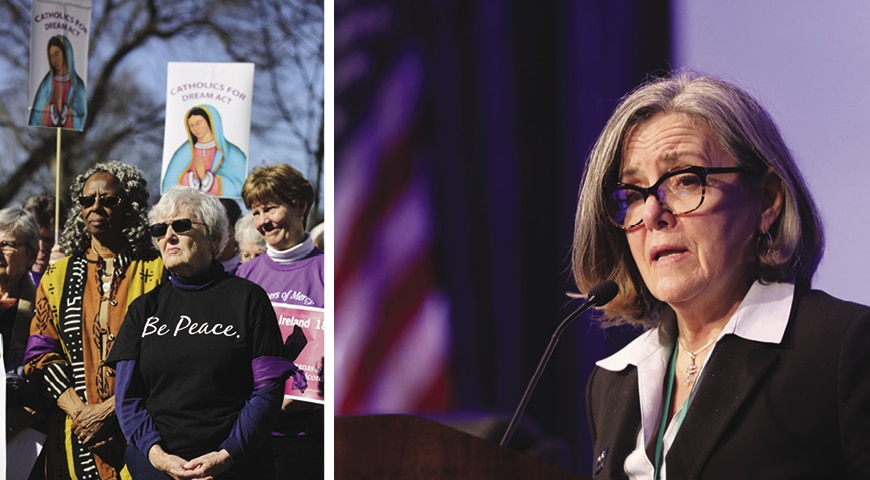
(Left) Outside the US Capitol in 2018, Sisters of Mercy and others participate in the Catholic Day of Action with Dreamers to press Congress to protect DACA recipients. This demonstration of solidarity brought together over 200 priests, women religious, and laypeople, some of whom were arrested for civil disobedience. (Right) Anna Marie Gallagher, executive director of the Catholic Legal Immigration Network, Inc. (CLINIC), speaks during a session of the US bishops’ general assembly in 2021.
Amy Haer, director of Catholic Charities in the Archdiocese of Atlanta, says that many of the Dreamers are no longer young: “Some of these people have had this status for nine years. They have built families and careers in the United States.”
She sometimes hears complaints that the Dreamers should come to the United States the way former immigrants did, through a legal portal. But Haer, who traces her own family’s lineage in the United States to the 17th century, notes that the times have changed. “They will say that my people came the right way. But the right way was a lot easier when your people came,” she says, noting the growth of restrictive immigration laws as the gates narrowed in the early 20th century.
Planting a Seed
Sandra Oñate will, along with many other young Dreamers, continue to speak out, arguing the case that massive deportations of those who have been here for decades and did not consciously violate the law are unrealistic, besides violating the Christian principle of welcoming the stranger articulated by Jesus in Matthew’s Gospel.
In reality, many of the Dreamers are not strangers. They are, argue immigration advocates and DACA recipients, as American as anyone else. Many don’t speak the language of their home countries and are often culturally disconnected from their countries of origin. They have largely become a part of life in the large urban centers on the coasts, as well as the suburbs of places such as Cincinnati and Atlanta, and small towns across the South and the Midwest.
Successfully describing themselves as Dreamers—conjuring up an image of American achievement—those in the movement are now promoting that picture in the hope that politicians can be persuaded that what is good for the Dreamers is also good for the nation. The struggle is sure to continue.
“At the end of the day,” says Oñate, “my option is to share my experience and to plant a seed.”
Back and Forth: A DACA Time Line
2001: With bipartisan sponsorship from Senators Orrin Hatch and Dick Durbin, the Development, Relief, and Education for Alien Minors (DREAM) Act is proposed; it is repeatedly rejected by Congress.
JUNE 2012: President Barack Obama establishes the Deferred Action for Childhood Arrivals (DACA) program.
AUGUST 2012: US Citizenship and Immigration Services (USCIS), under the Department of Homeland Security, begins accepting DACA applications.
SEPTEMBER 2017: President Donald Trump announces that DACA will be phased out.
JUNE 2020: The Supreme Court rules that the Trump administration improperly ended DACA and sends the case back to Homeland Security; meanwhile, the DACA program remains in place.
JANUARY 2021: President Joe Biden directs the secretary of Homeland Security, in consultation with the attorney general, to maintain and strengthen DACA.
JULY 2021: A Texas federal judge rules DACA illegal and blocks new applicants. Those currently in the program may keep their status during the appeal.
(Sources: Law Library, Howard University; Sandra Day O’Connor College of Law, Arizona State University, Ross-Blakley Law Library)
Check out our blog, Helping Dreamers, to learn more.

